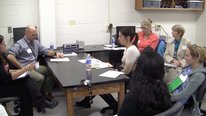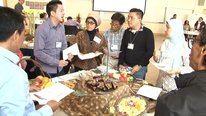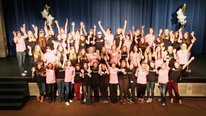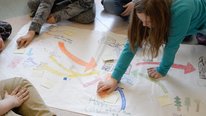- Raluca Ellis
- CUSP Program Director/Environmental Scientist
- Climate & Urban Systems Partnership
- http://www.cuspproject.org/
- The Franklin Institute
- Richard Johnson
- Climate & Urban Systems Partnership
- http://www.cuspproject.org/
- The Franklin Institute
- Michaela Labriole
- Climate & Urban Systems Partnership
- http://www.cuspproject.org/
- New York Hall of Science
- Mandi Lyon
- Climate & Urban Systems Partnership
- http://www.cuspproject.org/
- Carnegie Museum of Natural History
- Jarred McKee
- Climate & Urban Systems Partnership
- http://www.cuspproject.org/
- National Geographic Society
Presenters’
Choice Public
Choice
Choice Public
Choice
Public Discussion
Continue the discussion of this presentation on the Multiplex. Go to Multiplex











Colleen Lewis
Assistant Professor
This provided a really clear and helpful introduction to the work of CUSP!
The summary of the video says that CUSP works with community organizations. Are these primarily organizations working with adults? or is the content also appropriate for kids?
Can you provide some links to what types of activities you engage people with? The description here was illuminating:
http://www.cuspproject.org/learning-science/pri...
but I didn’t see a description of the specific activities from within the video here:
http://www.cuspproject.org/climate-science/reso...
Are there specific misconceptions about climate change that have been hard to address?
Thanks!
- Colleen
Mandi Lyon
Program Development Coordinator
Thanks for your questions, Colleen! Each city has a very diverse set of organizations that they work with, so our activities are designed to engage participants of all ages. For example, the tabletop activities have been tested with children and adults alike, and we’ve found we only need to facilitate the conversations a little differently depending on audience.
While we’ve all collaborated all along the way, each city has developed its own flavor. It’s probably easiest to get a feel for that by going to http://cuspproject.org and then clicking on each city to see what we do, who we work with, etc.
Since I’m speaking on behalf of Pittsburgh CUSP, I’ll share some links that help understand what’s happening in our city.
You can learn about the Pittsburgh network here:
http://pittsburgh.cuspproject.org/network/
Our Pittsburgh CUSP tabletop activities are described in detail launching from this page:
http://pittsburgh.cuspproject.org/kits/
In each city, we try to gather partners together a few times a year to share these kits during major festivals or event days. We call these gatherings “climate playgrounds” or “climate cities.” Here’s what one Pittsburgh CUSP partner had to say about a CUSP Climate Playground: http://ninemilerun.org/alcosan-open-house/
I don’t want to speak on the whole project’s behalf, but the biggest surprise I’ve had in 3.5 years of speaking with probably thousands of people about climate change is that people in our city don’t seem to be grappling with the science or the cause of climate change, they just want to know how to be a part of the solution.
Michaela Labriole
I would agree with Mandi’s comment about city residents, both adults and children, really looking to engage with solutions.
In addition to putting a New York frame on the CUSP tabletop activities Mandi linked to, CUSP New York has been using a digital map to engage audiences in viewing their cities in new ways.
http://cuspmap.org/
It has been interesting to see how the different types of activities work together.
Joni Falk
Fabulous video. I love the idea of gatherings and the fact that you are reaching kids in these informal settings, after school, and adults as well.
What have been your biggest challenges to date reaching these audiences and in scaling your work?
Mary Steiner
Hi Joni, Thanks for the question. One challenge in scaling has been transferring resources tested in one city for use in the others, trying to find the right balance between direct dissemination and flexibility of approach in each location. For example, in the original conception of the project the Pittsburgh hub was tasked with developing and evaluating tabletop activities, and then replicating them and sending them to the other cities. Having worked closely with our partners in Pittsburgh to develop kits that were locally relevant, we found that some activities were relatively easy to share with the other cities, but certainly not all. Rather, we are finding that the PROCESS of using and critiquing existing kits together as a network, and taking a stab at building rough prototypes of new kits together in workshops, generates discussion that grounds the group in the principles underlying CUSP (locally relevant impacts, solutions and opportunities to participate), while also allowing each city to tailor its activity library to its own educational goals and aesthetic principles. As the video says, climate change is a big, complex problem and having opportunities to think about how our own work connects to it and might even be a part of the solution to it has been empowering to our partners in each city.
Brian Drayton
I love this approach — I think it’s a critical kind of work to do. I have shaped much of my own thinking about climate change around the need just to get people talking about the issue — information is out there, but it’s the talking that stimulates a desire to know, especially when there’s a community full of people with a range of points of view.
I also really like the getting-the-hands-dirty approach.
Do you have a sense that people go home and talk about climate change with their neighbors/family/co-workers?
Mandi Lyon
Program Development Coordinator
Thanks so much, Brian! I think we’ve all found this approach very rewarding, too, as you can see in the video. I don’t have bigger data at hand, but I can cite a few examples from two Pittsburgh climate playgrounds: follow-up surveys that were sent about a month later to visitors to our big tent (where several activities were being presented by different organizations all under the CUSP banner) showed that about half of the respondents had at least one conversation about climate change sometime after the event. Some talked about the tabletop activities, others talked about other examples of impacts in Pittsburgh, and others about solutions they’d noticed around town because they’d experienced our activities at the event. A few of my favorite responses: “We talked about what we could be doing in our home lives and at school to decrease the effects of climate change – and how we can make more people aware of this” and “We talked about some of the activities and displays and how sometimes I feel like there is little being done and how some people find ways to blow off the urgency of climate issues. When going to events like this my faith in human kind is increased. Also, these events present the challenge that we all can do something to help.” Roughly half of the respondents also indicated that they either had or were planning to make some sort of behavior change in response to the activities they’d experienced. Additionally, responses from our project partners during event debriefs showed that the activity facilitators felt more supported and comfortable talking about climate change with the public after presenting together under the same big tent.
Michaela Labriole
Brian, your focus on conversations is so important and obviously critical to the work of CUSP.
The CUSP Map has helped us capture how people are thinking about and talking about climate change after they engage in other CUSP activities. After festival events or neighborhood programs, we’ve seen people post on the map to continue the conversation about climate change in their neighborhoods.
In addition to the evaluation we’ve done, there’s lots of anecdotal evidence that indicates that people do go home and talk about climate change. For instance, in New York, we’ve run into some of the same families at different festivals over the past few years of the project, and the families will share stories about how they’ve not only gone home and talked about climate change, but they’ve taken some sort of action based on what they learned.
Barry Fishman
Professor
So many great things going on in this program! I love the different age groups represented in the video. (And I’m fascinated by that kinetic umbrella thing!)
Question – how to you think about “impact” in a project like this? Is it just the number of participants? Is there any way to measure learning and/or change that doesn’t feel too off-putting to participants?
MaryAnn Steiner
A big piece of the learning that we have found to be important is the learning that happens between all of us in the city specific partner networks as we identify appropriate local impacts and solutions and determine how to best represent them. We have qualitative case studies of partners in Pittsburgh changing in their comfort level in talking about climate change and even adapting their programming to include climate change topics. Lauren Allen can say more about that. Then, as partners get on board they each bring access that helps to the audience and locations you mentioned in your post.
Karen Elinich
Barry – That kinetic umbrella thing was an attempt to meet people where they are. Here in Philadelphia, we’ve targeted a few particular neighborhoods for our interventions. One of those neighborhoods is Fishtown. Like many neighborhoods, Fishtown has a big spring community festival day each year. They have arts & crafts vendors, community outreach displays, and similar things to see/do. The big deal, though, is the Kinetic Sculpture Derby. It’s a highly competitive and extremely well-attended event. Our CUSP approach is all about meeting people where they are and speaking to them on their terms. It’s kind of a “when in Rome” approach. Or, “when in Fishtown.” So, we entered the derby and made a splash….literally, though the mudpit leg…and figuratively, though the incredible attention and interest we attracted with our undulating umbrellas. We also won the “best engineering” trophy, but that was just a bonus. The real win was the good will we generated and the exposure we gained.
Cullen White
Director
This seems like such a fascinating and powerful program. I’d love to learn more about how you introduce individual topics to the students and adults in CUSP. More specifically, how are you differentiating your teaching and learning strategies to suit such a broad audience of students and adults?
Richard Johnson
Hi, Cullen! Interestingly enough, we find that our teaching strategies don’t have to vary too much for these different audiences. Our approach is always hands-on and fun, and it seems to be universally appealing. Adults, even senior citizens, actually tell us how refreshing it is to learn in this manner, rather than the normal lecture based style that is usually the default for adult audiences. I think it’s particularly important to keep this in mind for climate change education, because people sometimes think that they should approach climate change differently, because of what a complex, scary topic it can be. At the end of the day, however, what’s going to keep people engaged is something that they like doing, that empowers them, and that is relevant to their lives.
Colleen Leithren
Very interesting and engaging. What would you say was the biggest challenge you faced as you put this program together?
Richard Johnson
Hi, Colleen. In the beginning, sustaining local stakeholder engagement was challenging at times. We were convening local organizations on the basis that they wanted to work together to engage the public in climate change, but we didn’t have anything too concrete to offer. We turned a corner when we culled the most recent research on climate change communication and landed on an approach to climate change education that is “Local, Relevant, Solutions-Focused.” Since then, it’s become our mantra, and our guidepost for all the things we do. Stakeholder engagement also started to flourish after we produced some concrete products that demonstrated our approach (CUSP map, kits, etc.), and began to provide opportunities for local stakeholders to do the same (via mini-grants).
Further posting is closed as the showcase has ended.